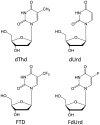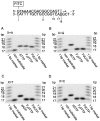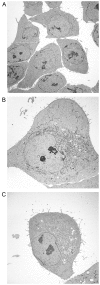Crucial roles of thymidine kinase 1 and deoxyUTPase in incorporating the antineoplastic nucleosides trifluridine and 2'-deoxy-5-fluorouridine into DNA
- PMID: 25901475
- PMCID: PMC4441292
- DOI: 10.3892/ijo.2015.2974
Crucial roles of thymidine kinase 1 and deoxyUTPase in incorporating the antineoplastic nucleosides trifluridine and 2'-deoxy-5-fluorouridine into DNA
Abstract
Trifluridine (FTD) and 2'-deoxy-5-fluorouridine (FdUrd), a derivative of 5-fluorouracil (5-FU), are antitumor agents that inhibit thymidylate synthase activity and their nucleotides are incorporated into DNA. However, it is evident that several differences occur in the underlying antitumor mechanisms associated with these nucleoside analogues. Recently, TAS-102 (composed of FTD and tipiracil hydrochloride, TPI) was shown to prolong the survival of patients with colorectal cancer who received a median of 2 prior therapies, including 5-FU. TAS-102 was recently approved for clinical use in Japan. These data suggest that the antitumor activities of TAS-102 and 5-FU proceed via different mechanisms. Thus, we analyzed their properties in terms of thymidine salvage pathway utilization, involving membrane transporters, a nucleoside kinase, a nucleotide-dephosphorylating enzyme, and DNA polymerase α. FTD incorporated into DNA with higher efficiency than FdUrd did. Both FTD and FdUrd were transported into cells by ENT1 and ENT2 and were phosphorylated by thymidine kinase 1, which showed a higher catalytic activity for FTD than for FdUrd. deoxyUTPase (DUT) did not recognize dTTP and FTD-triphosphate (F3dTTP), whereas deoxyuridine-triphosphate (dUTP) and FdUrd-triphosphate (FdUTP) were efficiently degraded by DUT. DNA polymerase α incorporated both F3dTTP and FdUTP into DNA at sites aligned with adenine on the opposite strand. FTD-treated cells showed differing nuclear morphologies compared to FdUrd-treated cells. These findings indicate that FTD and FdUrd are incorporated into DNA with different efficiencies due to differences in the substrate specificities of TK1 and DUT, causing abundant FTD incorporation into DNA.
Figures






Similar articles
-
A novel combination antimetabolite, TAS-102, exhibits antitumor activity in FU-resistant human cancer cells through a mechanism involving FTD incorporation in DNA.Int J Oncol. 2004 Sep;25(3):571-8. Int J Oncol. 2004. PMID: 15289858
-
A novel antimetabolite, TAS-102 retains its effect on FU-related resistant cancer cells.Int J Mol Med. 2004 Apr;13(4):545-9. Int J Mol Med. 2004. PMID: 15010854
-
Repeated oral dosing of TAS-102 confers high trifluridine incorporation into DNA and sustained antitumor activity in mouse models.Oncol Rep. 2014 Dec;32(6):2319-26. doi: 10.3892/or.2014.3487. Epub 2014 Sep 17. Oncol Rep. 2014. PMID: 25230742 Free PMC article.
-
TAS-102, a novel antitumor agent: a review of the mechanism of action.Cancer Treat Rev. 2015 Nov;41(9):777-83. doi: 10.1016/j.ctrv.2015.06.001. Epub 2015 Jun 6. Cancer Treat Rev. 2015. PMID: 26428513 Free PMC article. Review.
-
TAS-102: a novel antimetabolite for the 21st century.Future Oncol. 2016 Jan;12(2):153-63. doi: 10.2217/fon.15.276. Epub 2015 Nov 30. Future Oncol. 2016. PMID: 26616466 Free PMC article. Review.
Cited by
-
Trifluridine/Tipiracil: A Review in Metastatic Colorectal Cancer.Drugs. 2016 Sep;76(14):1393-402. doi: 10.1007/s40265-016-0633-9. Drugs. 2016. PMID: 27568360 Review.
-
Issues and limitations of available biomarkers for fluoropyrimidine-based chemotherapy toxicity, a narrative review of the literature.ESMO Open. 2021 Jun;6(3):100125. doi: 10.1016/j.esmoop.2021.100125. Epub 2021 Apr 23. ESMO Open. 2021. PMID: 33895696 Free PMC article. Review.
-
MicroRNA profiles involved in trifluridine resistance.Oncotarget. 2017 May 23;8(32):53017-53027. doi: 10.18632/oncotarget.18078. eCollection 2017 Aug 8. Oncotarget. 2017. PMID: 28881790 Free PMC article.
-
Potential role of polymorphisms in the transporter genes ENT1 and MATE1/OCT2 in predicting TAS-102 efficacy and toxicity in patients with refractory metastatic colorectal cancer.Eur J Cancer. 2017 Nov;86:197-206. doi: 10.1016/j.ejca.2017.08.033. Epub 2017 Oct 6. Eur J Cancer. 2017. PMID: 28992563 Free PMC article.
-
Prognostic impact of severe neutropenia in colorectal cancer patients treated with TAS-102 and bevacizumab, addressing immortal-time bias.BMC Cancer. 2023 Nov 8;23(1):1078. doi: 10.1186/s12885-023-11618-3. BMC Cancer. 2023. PMID: 37940878 Free PMC article.
References
-
- Weber G. Biochemical strategy of cancer cells and the design of chemotherapy: G. H. A. Clowes Memorial Lecture. Cancer Res. 1983;43:3466–3492. - PubMed
-
- Johnston PG, Benson AB, III, Catalano P, Rao MS, O’Dwyer PJ, Allegra CJ. Thymidylate synthase protein expression in primary colorectal cancer: Lack of correlation with outcome and response to fluorouracil in metastatic disease sites. J Clin Oncol. 2003;21:815–819. doi: 10.1200/JCO.2003.07.039. - DOI - PubMed
MeSH terms
Substances
LinkOut - more resources
Full Text Sources
Other Literature Sources
Medical
Miscellaneous

